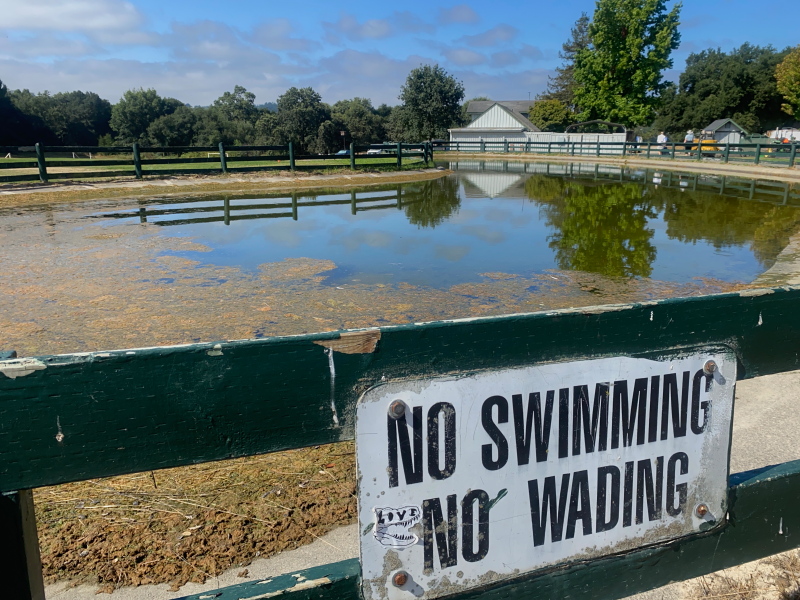Blue Green Algae Hazard

Harmful Algal Bloom Hazard
7 August 2023 Mill Station Road, The Green Valley of Sonoma County 790 words
Algal blooms create a real hazard for dogs who love water. The toxins produced by these blooms can damage a dog’s vital organs or even kill them. Don’t let your dog become a statistic. Pay close attention to posted warnings for algal blooms. Keep your dog away from warm, stagnant water that you suspect might be affected. Instead, seek out clear, cool, fast running water or deep, clear, cold fresh water and be particularly wary of any water your dog may get his paws into when it’s sunny and warm out. Note that in some cases of algal bloom toxicity, the tainted water was clear. However, in most cases, a green or blue green color, or a surface scum was apparent. Be sure to bring lots of drinking water on your adventures together so your dog never gets thirsty.
I don’t have many statistics for how many dogs fall victim to poisoning by algal blooms. A CDC study suggests that dogs are leading victims. https://www.cdc.gov/habs/data/2019-ohhabs-data-summary.html#events Other leading victims are marine mammals and fish. To keep things in perspective, the CDC reported that in 2019, only 27 dogs from 19 U.S. states were affected. This means the chances of your dog getting poisoned are pretty slim. But losing a pet to poisoning by algal blooms is something you can easily avoid once you’re aware of the dangers.
Algal Blooms
The organisms behind algal blooms include algae, diatoms, cyanobacteria, dinoflagellates,and perhaps a symbiotic combination of more than one of these. Blooms occur in both fresh and saltwater, but the fresh water blooms are the biggest concern unless your dog eats a lot of seafood. Blooms happen when these organisms multiply rampantly under certain conditions. Blooms are more likely when the water in ponds, lakes, rivers and streams stops flowing, becomes stagnant and warms up to around 75 F or so after a series of sunny days. A bloom can receive a boost from a surplus of artificial nutrients. For example, nitrogen rich nutrients from agricultural runoff, septic leakage, sewage outfalls, or runoff from well kept lawns and golf courses can all promote an algal bloom. These conditions are common across North America in summer through early autumn. There are accounts of dogs dying after playing or swimming in warm, stagnant water in California, Georgia and even Saskatchewan. In other words, algal blooms are ubiquitous and only need the combination of warm, stagnant and nutrient rich water under sunny skies to become a real hazard to your best friend.
Algal Bloom Toxins
The organisms behind algal blooms produce a whole slew of potent toxins. I suspect that they naturally release their toxins into the surrounding water. Alternatively, the toxins escape when the organisms die. Either way, your dog doesn’t necessarily need to ingest the algal scum itself to get poisoned. Your dog may risk being poisoned by drinking nearby water or even by licking his fur after splashing around.
I suspect that the scenario is quite different for salt water blooms in the ocean. It’s likely that the toxins in seawater are very dilute. Marine mammals and fish get poisoned when they or their prey ingest vast amounts of plankton, with toxins becoming more concentrated as you move up the food chain. So I wouldn’t worry about your dog getting poisoned from playing in the ocean.
Signs and Symptoms
I don’t have a comprehensive list of the signs and symptoms, but here are a few of the scary ones to get your attention: lethargy, vomiting, convulsions, and death.
Treatment
The really scary thing is that cyanotoxins are fast acting. Dogs can perish only a few hours after the onset. There are no known antidotes (as far as I know), so treatment options are woefully limited. Prevention is really the only cure in this case.
An Ounce of Prevention
I think the best strategy is to keep your dog clear of trepid, stagnant waters during the warm and dry months of summer through early fall. Take note of posted warnings, or if in doubt, ask. Seek out the clean, cold, clear, deep bodies of water that have no prior record of algal blooms. Don’t rely on your dog’s sense of taste or dignity to protect it from algal toxins. Case in point: my dog will drink anything out on the trail, whether I let him or not. He seems to prefer dirt soup to clean fresh water. He’ll even lap up the beach wash of the salty Pacific Ocean. He’s also slaked his thirst from the filthy flooded trails during California’s wet months of winter.